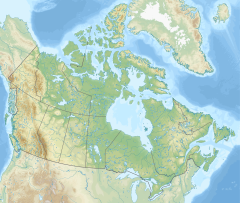
Back مرصد ديفيد دنلاب ARZ David Dunlap Observatory German Observatorio David Dunlap Spanish Observatoire David Dunlap French David Dunlap Observatory Italian デービッド・ダンラップ天文台 Japanese Observatório David Dunlap Portuguese Обсерватория им. Дэвида Данлэпа Russian David Dunlap Observatory Slovak
 The 74-inch (1.9 m) telescope (left) and Administration Building (right) at the David Dunlap Observatory | |||||||
| Alternative names | DDO | ||||||
|---|---|---|---|---|---|---|---|
| Named after | David Alexander Dunlap | ||||||
| Organization | University of Toronto (1935–2008) Royal Astronomical Society of Canada (2009–2016) City of Richmond Hill (2018–) | ||||||
| Observatory code | 779 | ||||||
| Location | Richmond Hill, Ontario, Canada | ||||||
| Coordinates | 43°51′46″N 79°25′22″W / 43.8629°N 79.4227°W | ||||||
| Altitude | 224 m (735 ft) | ||||||
| Weather | 67% clear nights[1] | ||||||
| Established | 31 May 1935 | ||||||
| Website | astro.utoronto.ca/DDO (1935–2008), www.theddo.ca (2009–2016), | ||||||
| Telescopes | |||||||
| |||||||
| | |||||||
| Official name | David Dunlap Observatory National Historic Site of Canada | ||||||
| Designated | 31 July 2019 | ||||||
The David Dunlap Observatory (DDO) is an astronomical observatory site in Richmond Hill, Ontario, Canada. Established in 1935, it was owned and operated by the University of Toronto until 2008. It was then acquired by the city of Richmond Hill, which provides a combination of heritage preservation, unique recreation opportunities and a celebration of the astronomical history of the site. Its primary instrument is a 74-inch (1.88 m) reflector telescope, at one time the second-largest telescope in the world, and still the largest in Canada. Several other telescopes are also located at the site, which formerly also included a small radio telescope. The scientific legacy of the David Dunlap Observatory continues in the Dunlap Institute for Astronomy & Astrophysics, a research institute at the University of Toronto established in 2008.
The DDO is the site of a number of important scientific studies, including pioneering measurements of the distance to globular clusters, providing the first direct evidence that Cygnus X-1 was a black hole, and the discovery that Polaris was stabilizing and appeared to be "falling out" of the Cepheid variable category.[1] Located on a hill, yet still relatively close to sea level at 730 feet (220 m) altitude, and now surrounded by urban settlement, its optical astronomy ability has been reduced as compared to other remote observatory sites around the world. On 31 July 2019, the DDO was accepted by the National Historic Board as a National Historic Site of Canada.[2]
- ^ Polaris – The Story Continues Archived 30 September 2007 at the Wayback Machine Photoelectric Photometry Newsletter, American Association of Variable Star Observers, May 1998
- ^ Government of Canada Announces Eight New National Historic Designations, Parks Canada news release, 31 July 2019
© MMXXIII Rich X Search. We shall prevail. All rights reserved. Rich X Search
